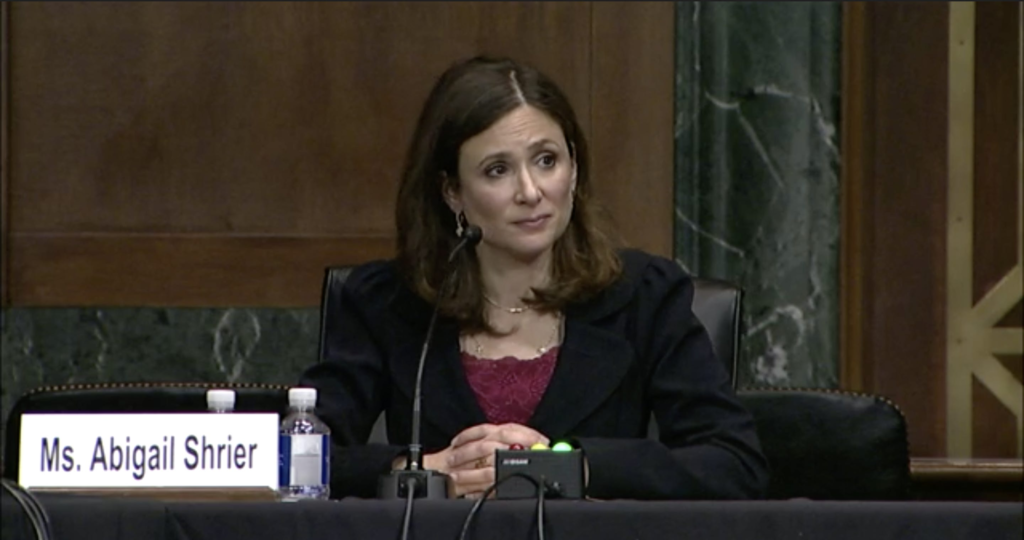- Visitor:29
- Published on:
Irreversible Damage: The Transgender Craze Seducing Our Daughters
This book is not about transgender adults, though in the course of writing it I interviewed many—those who present as women and those who present as men. They are kind, thoughtful, and decent. They describe the relentless chafe of a body that feels all wrong, that seems somehow a lie. It is a feeling that has dogged them for as long as they can remember.

- The following piece is taken from the introductory section of the 2020 book by Abigail Shrier titled “Irreversible Damage: The Transgender Craze Seducing Our Daughters” which endorses the discredited concept of rapid-onset gender dysphoria. ROGD is not recognized as a medical diagnosis by any major professional institution and is not backed by credible scientific evidence.
Lucy had always been a “girly girl,” her mother swore. As a child, she would climb into high heels and frilly dresses to do her chores, retiring to a bedroom packed with Beanie Babies and an expansive array of pets she tended—rabbits, gerbils, parakeets. Dress-up was a favorite game, and she had a trunk full of gowns and wigs she would dip into, inhabiting an assortment of characters—every one of them female. She embraced the girlhood of the late 1990s, adoring the Disney princess movies, especially The Little Mermaid, and later, Twilight and its sequels.
Lucy was precocious. At five, she read at a fourth grade level and showed early artistic promise, for which she would later win a district- wide prize. But as she reached middle school, her anxiety spiked. The waters of depression rushed in. Her affluent parents—mom was a prominent Southern attorney—took her to psychiatrists and therapists for treatment and medication, but no amount of talk therapy or drugs leveled her social obstacles: the cliques that didn’t want her, her nervous tendency to flub social tests casually administered by other girls.
Boys gave her less trouble, and she had male friends and boyfriends throughout high school. Home life wasn’t easy; her older sister fell into a drug addiction that tore through the family like a hurricane, consuming both parents’ attention. Lucy’s ups and downs eventually resolved in a bipolar II diagnosis. But making and keeping female friends proved a trial that never concluded in her favor nor ever really let up.
Liberal arts college in the Northeast began, as it so often does these days, with an invitation to state her name, sexual orientation, and gender pronouns. Lucy registered the new chance at social acceptance, a first whiff of belonging. When her anxiety flared later that autumn, she decided, with several of her friends, that their angst had a fashionable cause: “gender dysphoria.” Within a year, Lucy had begun a course of testosterone. But her real drug—the one that hooked her— was the promise of a new identity. A shaved head, boys’ clothes, and a new name formed the baptismal waters of a female-to-male rebirth.
The next step—if she took it—would be “top surgery,” a euphemism for a voluntary double mastectomy.
“How do you know this wasn’t gender dysphoria?” I asked her mother.
“Because she’d never shown anything like that. I never heard her ever express any discomfort over her body. She got her period when she was in the fourth grade, and that was super embarrassing for her because it was so early, but I never heard her complain about her body.” Her mother paused as she searched for an apt memory. “I made her get a pixie haircut when she was five and she just cried buckets over it because she thought she looked like a boy. She hated it.” And then, “She’d dated boys. She’d always dated boys.”

This book is not about transgender adults, though in the course of writing it I interviewed many—those who present as women and those who present as men. They are kind, thoughtful, and decent. They describe the relentless chafe of a body that feels all wrong, that seems somehow a lie. It is a feeling that has dogged them for as long as they can remember.
Their dysphoria certainly never made them popular; more often than not, it was a source of unease and embarrassment. Growing up, none of them knew a single other trans person, and the internet did not yet exist to supply mentors. But they didn’t want or need mentors: they knew how they felt. Presenting as the opposite sex simply makes them more comfortable. They do not seek to be celebrated for the life they have chosen. They want to “pass”—and, in many cases, to be left alone.
I spoke with some on the record and others off. For their honesty and courage, they easily won my admiration. One became a friend. That so much trans activism claims to speak in their name is neither their fault nor their intention. They have very little to do with the current trans epidemic plaguing teenage girls.
The Salem witch trials of the seventeenth century are closer to the mark. So are the nervous disorders of the eighteenth century and the neurasthenia epidemic of the nineteenth century.1 Anorexia nervosa,2 repressed memory,3 bulimia, and the cutting contagion in the twentieth.4 One protagonist has led them all, notorious for magnifying and spreading her own psychic pain: the adolescent girl.5 Her distress is real. But her self-diagnosis, in each case, is flawed—more the result of encouragement and suggestion than psychological necessity.
Three decades ago, these girls might have hankered for liposuction while their physical forms wasted away. Two decades ago, today’s trans-identified teens might have “discovered” a repressed memory of childhood trauma. Today’s diagnostic craze isn’t demonic possession— it’s “gender dysphoria.” And its “cure” is not exorcism, laxatives, or purging. It’s testosterone and “top surgery.”
You’re not supposed to pick favorites among the amendments, because it’s silly, but I have one, and it’s the First. My commitment to free speech led me into the world of transgender politics, through a back door.
In October 2017, my own state, California, enacted a law that threatened jail time for healthcare workers who refuse to use patients’ requested gender pronouns.
New York had adopted a similar law, which applied to employers, landlords, and business owners.
Both laws are facially and thoroughly unconstitutional. The First Amendment has long protected the right to say unpopular things without government interference. It also guarantees our right to refuse to say things the government wants said.
This isn’t a matter of constitutional nuance; it’s remarkably straightforward. In West Virginia State Board of Education v. Barnette (1943), the Supreme Court upheld students’ right not to salute an American flag. Writing for the majority, Justice Robert H. Jackson declared, “If there is any fixed star in our constitutional constellation, it is that no official, high or petty, can prescribe what shall be orthodox in politics, nationalism, religion or other matters of opinion or force citizens to confess by word or act their faith therein.” If the government can’t force students to salute a flag, the government can’t force a healthcare worker to utter a particular pronoun. In America, the government can’t make people say things—not even for the sake of politeness. Not for any reason at all.
I wrote about this in the Wall Street Journal, under the headline “The Transgender Language War,” and a reader—a prominent Southern lawyer, Lucy’s mother—saw my piece and found something in it: hope. She contacted me under a pseudonym and asked me to write about her daughter, who had announced during adolescence that she was “transgender”—despite never having shown any signs of gender dysphoria in her youth. She said Lucy had discovered this identity with the help of the internet, which provides an endless array of transgender mentors who coach adolescents in the art of slipping into a new gender identity—what to wear, how to walk, what to say. Which internet companies sell the best breast binders (a breast-compression garment, worn under clothes); which organizations send them for free and guarantee discreet packaging so that parents never find out. How to persuade doctors to supply the hormones you want. How to deceive parents—or, if they resist your new identity, how to break away entirely.
Under the influence of testosterone and the spell of transgression—the mother said—Lucy became churlish and aggressive, refusing to explain this new identity or answer any questions about it. She accused her mother of being a “gatekeeper” and “transphobe.” Lucy’s manufactured story of having “always known she was different” and having “always been trans,” her mother later discovered, had been lifted verbatim from the internet.
In her new, highly combustible state, Lucy would fly into rage if her parents used her legal name—the one they had given her—or failed to use her new pronouns. In short order, her parents hardly recognized her. They became alarmed by Lucy’s sudden thrall to a gender ideology that seemed, well, a lot of mumbo jumbo, biologically speaking. Her mother said it seemed as though Lucy had joined a cult; she feared it might never release her daughter. Gender dysphoria—formerly known as “gender identity disorder”—is characterized by a severe and persistent discomfort in one’s biological sex.8 It typically begins in early childhood—ages two to four—though it may grow more severe in adolescence. But in most cases—nearly 70 percent —childhood gender dysphoria resolves.9 Historically, it afflicted a tiny sliver of the population (roughly .01 percent) and almost exclusively boys. Before 2012, in fact, there was no scientific literature on girls ages eleven to twenty-one ever having developed gender dysphoria at all.
In the last decade that has changed, and dramatically. The Western world has seen a sudden surge of adolescents claiming to have gender dysphoria and self-identifying as “transgender.” For the first time in medical history, natal girls are not only present among those so identifying—they constitute the majority.10 Why? What happened? How did an age group that had always been the minority of those afflicted (adolescents) come to form the majority? Perhaps more significantly—why did the sex ratio flip: from overwhelmingly boys, to majority adolescent girls? I liked Lucy’s mother, the Southern lawyer, and fell readily into the story she told, but I was an opinion writer, not an investigative reporter. I passed her story on to another journalist and assured Lucy’s mother she was in good hands. Long after I had moved on to other topics for the Wall Street Journal and the lawyer was swept from my inbox, her story remained stubbornly lodged in my brain.
Three months later, I got back in touch with Lucy’s mother and all the contacts she had initially sent. I spoke with physicians— endocrinologists, psychiatrists, world-renowned psychologists specializing in gender dysphoria. I spoke with psychotherapists. I spoke with transgender adolescents and transgender adults to gain a glimpse of the interiority of their experience, the liberating tug of cross-sex identification. I also spoke with “desisters,” those who once identified as transgender and later stopped, and with “detransitioners,” those who had undergone medical procedures to alter their appearances, only to arrive at regret and scramble to reverse course. The more I learned about the adolescents who suddenly identify as transgender, the more haunted I became by one question: what’s ailing these girls?
In January 2019, the Wall Street Journal ran my piece, “When Your Daughter Defies Biology.” It provoked nearly a thousand comments, and hundreds of responses to those comments. A transgender writer, Jennifer Finney Boylan, quickly wrote a rebuttal in an op-ed that appeared two days later in the New York Times. Her op-ed garnered hundreds of comments and hundreds more reactions to those comments. All of a sudden, I was flooded with emails from readers who had experienced with their own children the phenomenon I had described or had witnessed its occurrence at their kids’ schools— clusters of adolescents in a single grade, suddenly discovering transgender identities together, begging for hormones, desperate for surgery.
When transgender activists attacked me online, I offered them the opportunity to tell me their stories as well. Several took me up on this, and we spoke. Detransitioners got in touch too. I opened a Tumblr account and invited transgender individuals and detransitioners to speak with me; many did. I sent the same invitations on Instagram, where hashtags like #testosterone, #transboy, and #ftm link hundreds of thousands of followers. Again and again, I reiterated my desire to listen to anyone who had something to offer on this issue. The responses I received formed the basis of this book.

This is a story Americans need to hear. Whether or not you have an adolescent daughter, whether or not your child has fallen for this transgender craze, America has become fertile ground for this mass enthusiasm for reasons that have everything to do with our cultural frailty: parents are undermined; experts are over–relied upon; dissenters in science and medicine are intimidated; free speech truckles under renewed attack; government healthcare laws harbor hidden consequences; and an intersectional era has arisen in which the desire to escape a dominant identity encourages individuals to take cover in victim groups.
To tell the story of these adolescent girls, I conducted nearly two hundred interviews and spoke to over four dozen families of adolescents. I have relied in part on parent accounts. Since traditional dysphoria begins in early childhood and has long been marked by a “persistent, insistent and consistent”11 sense of a child’s discomfort in his body (not something a young child can easily hide) parents are often in the best position to know whether the passionate dysphoria of adolescence began in early childhood. They are in the best position to know, in other words, whether the distress afflicting so many teenage girls represents traditional gender dysphoria or a different phenomenon altogether.
Parents cannot entirely be trusted to know how their adolescents feel about their transgender identities or the new lives forged in its name. But parents can report the facts of their kids’ academic or professional standing, their financial stability and family formation or lack thereof, and even, sometimes, their social successes and failures. Are these transgender-identified adolescents still in school, or did they drop out? Do they maintain contact with old friends? Do they speak to any family members at all? Are they building toward a future with a romantic partner? Are they engaged in subsistence living on wages from the local coffee shop?
I do not pretend to capture these adolescents’ whole stories, much less the fullness of the transgender experience. Transgender success stories are everywhere told and celebrated. They march under the banner of civil rights. They promise to breach the next cultural frontier, to shatter one more basis of human division.
But the phenomenon sweeping teenage girls is different. It originates not in traditional gender dysphoria but in videos found on the internet. It represents mimicry inspired by internet gurus, a pledge taken with girlfriends—hands and breath held, eyes squeezed shut. For these girls, trans identification offers freedom from anxiety’s relentless pursuit; it satisfies the deepest need for acceptance, the thrill of transgression, the seductive lilt of belonging.
As one transgender adolescent, “Kyle,” put it to me: “Arguably, the internet is half the reason I had the courage to come out. Chase Ross—a YouTuber. I was twelve. I followed him religiously.” Chase Ross was kind enough to speak to me, to help me understand what’s in the sauce. I present his story in Chapter Three.
This is the story of the American family—decent, loving, hardworking and kind. It wants to do the right thing. But it finds itself set in a society that increasingly regards parents as obstacles, bigots, and dupes. We cheer as teenage girls with no history of dysphoria steep themselves in a radical gender ideology taught in school or found on the internet. Peers and therapists and teachers and internet heroes egg these girls on. But here, the cost of so much youthful indiscretion is not a piercing or tattoo. It’s closer to a pound of flesh.
Some small proportion of the population will always be transgender. But perhaps the current craze will not always lure troubled young girls with no history of gender dysphoria, enlisting them in a lifetime of hormone dependency and disfiguring surgeries. If this is a social contagion, society—perhaps—can arrest it.
No adolescent should pay this high a price for having been, briefly, a follower.
Bibliography:
Shrier, Abigail, Introduction: The Contagion, Irreversible damage: The transgender craze seducing our daughters. Simon and Schuster, 2020.
Center for Indic Studies is now on Telegram. For regular updates on Indic Varta, Indic Talks and Indic Courses at CIS, please subscribe to our telegram channel !
- 14 min read
- 0
- 0










